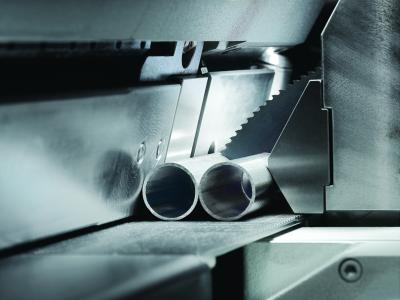
BLM Group USA’s Twincut is a CNC tube sawing machine capable of cutting parts in two different lengths simultaneously. Equipped with an automatic feeder, bars are loaded and cut, and then finished parts are unloaded automatically for a continuous, high productivity operation. The double bar configuration more than doubles output, guaranteeing the lowest possible part cost. It’s robust, reliable and fully-automatic for extremely efficient, continuous, unmanned, saw cutting operations.
The Twincut is available in single or double bar configurations, and can cut bundles of round, square, rectangular and other shaped aluminum and steel tubes. It can handle material up to 3.15” in diameter (80 mm) for single bar applications or 1.77” in diameter (45 mm) for double bar applications, and maximum part lengths of 240” (6,090 mm).
To boost throughput, it also features three unloading positions to separate clean parts from scrap and chips without interrupting production. Two are dedicated to production parts — at the front and rear of the machine — to differentiate the cut lengths and to change out collection boxes. The third discharge location is dedicated to bar end scrap and chips, which are collected and removed from the cutting zone by powerful air jets.
After cutting, the part ends can be automatically wire brushed to remove any burr. Part length can also be measured and certified, and systematically collected in finished part containers, sorted by programmed shape and size. An automatic washing system, entirely made of stainless steel and thermally insulated, is available for even more complete cleaning results.
Contact Details
Related Glossary Terms
- burr
burr
Stringy portions of material formed on workpiece edges during machining. Often sharp. Can be removed with hand files, abrasive wheels or belts, wire wheels, abrasive-fiber brushes, waterjet equipment or other methods.
- computer numerical control ( CNC)
computer numerical control ( CNC)
Microprocessor-based controller dedicated to a machine tool that permits the creation or modification of parts. Programmed numerical control activates the machine’s servos and spindle drives and controls the various machining operations. See DNC, direct numerical control; NC, numerical control.
- sawing
sawing
Machining operation in which a powered machine, usually equipped with a blade having milled or ground teeth, is used to part material (cutoff) or give it a new shape (contour bandsawing, band machining). Four basic types of sawing operations are: hacksawing (power or manual operation in which the blade moves back and forth through the work, cutting on one of the strokes); cold or circular sawing (a rotating, circular, toothed blade parts the material much as a workshop table saw or radial-arm saw cuts wood); bandsawing (a flexible, toothed blade rides on wheels under tension and is guided through the work); and abrasive sawing (abrasive points attached to a fiber or metal backing part stock, could be considered a grinding operation).
- sawing machine ( saw)
sawing machine ( saw)
Machine designed to use a serrated-tooth blade to cut metal or other material. Comes in a wide variety of styles but takes one of four basic forms: hacksaw (a simple, rugged machine that uses a reciprocating motion to part metal or other material); cold or circular saw (powers a circular blade that cuts structural materials); bandsaw (runs an endless band; the two basic types are cutoff and contour band machines, which cut intricate contours and shapes); and abrasive cutoff saw (similar in appearance to the cold saw, but uses an abrasive disc that rotates at high speeds rather than a blade with serrated teeth).
- sawing machine ( saw)2
sawing machine ( saw)
Machine designed to use a serrated-tooth blade to cut metal or other material. Comes in a wide variety of styles but takes one of four basic forms: hacksaw (a simple, rugged machine that uses a reciprocating motion to part metal or other material); cold or circular saw (powers a circular blade that cuts structural materials); bandsaw (runs an endless band; the two basic types are cutoff and contour band machines, which cut intricate contours and shapes); and abrasive cutoff saw (similar in appearance to the cold saw, but uses an abrasive disc that rotates at high speeds rather than a blade with serrated teeth).
